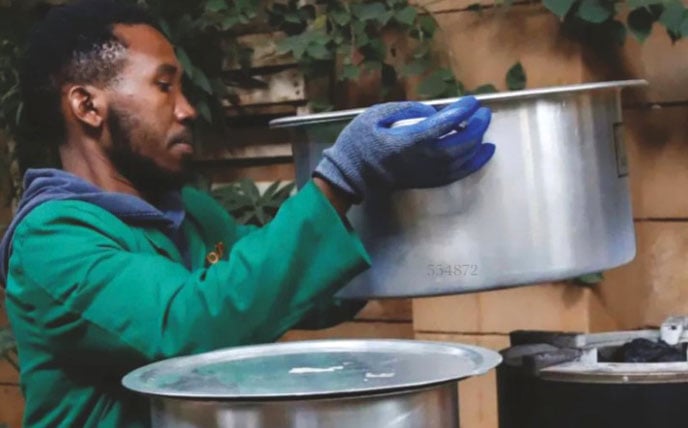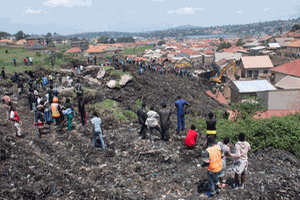How clean cooking will build Uganda’s climate resilience

Only four per cent of households use clean energy such as ethanol, electricity, efficient cook stoves, and LPG for cooking. Photo | File
What you need to know:
- In a bid to mitigate the effects of climate change, Uganda is adopting a number of measures such as climate smart agriculture and technologies, electric-powered buses, and the use of renewable energy. As Gillian Nantume writes, encouraging the middle class to transition from using solid fuels for cooking to clean cooking fuels will go a long way in mitigating climate change effects.
For Miriam Nakiwala, an accountant in the private sector, cooking anything beyond a snack means lighting the metallic sigiri (charcoal stove) the family keeps in their detached kitchen. The gas (Liquefied Petroleum Gas - LPG) cooker is kept in her indoor kitchen.
However, Nakiwala rarely lights the gas cooker, only using it to warm sauce for the family’s supper. The idea is to make the gas last at least three months before a refill is required. In Entebbe Municipality, Wakiso district, where she resides, refilling a 12kg gas cylinder costs Shs113,000.
“Since the president banned the transportation of charcoal, we have suffered. In Entebbe, half a bag of charcoal now costs Shs90,000, which is a lot of money for a family of six. Before the ban, I used to buy charcoal whenever I had an upcountry assignment,” she says.
At the time, half a bag of charcoal upcountry cost between Shs15,000 and Shs30,000 depending on the region. In May 2023, President Yoweri Museveni issued Executive Order No 3 in which he banned the production of, and trade in, charcoal in northern Uganda, in a bid to protect the environment. Since then, thousands of bags of charcoal have been confiscated, leading to dwindling supplies to traders. This, in turn, has caused charcoal prices in urban areas to skyrocket.
“Nowadays, I only buy charcoal measured in basins to take us through one week at a time. Gas is expensive but cooking with electricity is an option I cannot afford,” Nakiwala adds. Her situation mirrors the quandary in which thousands in Uganda’s middle class find themselves. Results from the National Population and Housing Census (NPHC) 2024 show that 91 percent of households in the country use solid fuel – charcoal and firewood – as their primary energy source for cooking.
Only four percent of households use clean energy such as ethanol, electricity, efficient cook stoves, and LPG, for cookingRenewable energy sourcesMost of Uganda’s energy comes from renewable sources, the highest percentage of which is from hydropower. The electricity sector has rapidly expanded since 2001 to an estimated 2,000 megawatts of hydropower potential.
Anthony Wolimbwa, the national coordinator for the Climate Action Network Uganda (CAN-U), says there has been substantial gain in terms of electricity production. “This is evidenced by developments in the sector such as the construction of Karuma Hydropower Station, which is the largest power generating dam in the country, the expansion at Kiira and Isimba (hydropower stations) and other smaller projects in western and eastern Uganda,” he says.
However, despite the surplus electricity generated, only 25 percent of households are connected to the national grid. Of these, only about two percent can afford to cook on electricity. “The production, evacuation and utilisation of electricity have to be harmonised. The general challenge is that while a lot of electricity now being produced, most of it is not used because people do not have access to it,” Wolimbwa adds. Besides biomass and electricity, Uganda has other sources of renewable energy, which include ethanol, geothermal, peat, wind energy, and solar.
The latter has the highest adoption rate, especially in the rural parts of the country. According to the NHPC 2024, 28 percent of households are connected to solar energy. Dr Peter Babyenda, the policy engagement coordinator, with Makerere University’s Environment for Development Initiative (EfD-MAK), says while the concentration of solar energy has greatly improved, it is only used for lighting and charging phones.
“We want to move an extra mile and encourage the use of solar for cooking because that is where we have a problem. We want women in rural areas to stop cooking using rudimentary biomass. The use of firewood has adverse health effects because of the smoke it emits,” he says. Indoor pollution and carbon dioxide inhalation are a major health concern, especially for those who cook in closed spaces.
Secondly, when using biomass for cooking, a lot of heat is generated leading to wastage of the fuel. This necessitates one to keep adding more charcoal or firewood until the food is ready. “Household pollution is making women half blind and causing infant mortality. As a country, we lose close to 30,000 people per year from smoke-related illnesses. The cost of treating these diseases is also high,” Dr Babyenda explains.
The heavy reliance on biomass cooking energy has led to a high deforestation rate, depleting Uganda’s forest cover to about 12 percent. People in the rural areas may not manage to install solar for cooking because it is quite costly. James Baanabe, an energy consultant with the Eastern, Central and Southern Africa (ECASA) Group of Consultants, advises that they should efficiently use whatever form of energy is available to them.
“They can construct the Lorena stoves, which are smokeless. The stove uses less firewood than the three-stone open fire. It produces more heat and therefore, cooks food faster. There are also improved mud stoves (IMS) that use less fuel and produce less smoke. They can save up to 65 percent on firewood,” he explains. Baanabe says the government needs to heavily promote the use of Lorena stoves and improved mud stoves.
“Unfortunately, promotion needs a lot of resources. Sometimes, the government depends on donor funds but nowadays donors are no longer keen on things to do with biomass or solid fuels. They would rather promote other alternatives,” he says.
During the 2023 United National Climate Change Conference (COP28), countries pledged to triple renewable capacity by 2030 as well as transitioning away from fossil fuels in energy systems so as to achieve net zero by 2050. According to the recently released Renewable Energy Tracker 2024, published by the Platform for Action for Renewable Energy, within the CAN International Secretariat, countries are not on track to achieve the tripling goal.
“Annual improvements in energy efficiency fell to 1.3 percent in 2023, far below the four percent needed by 2030. For the first time in over a decade, the number of people without basic access to electricity increased from the previous year, reaching 685 million in 2022 (an increase of 10 million since 2021), while 2.1 billion people still lack access to clean cooking fuels and technologies,” the tracker reads.
Transitioning to clean cookingWhile Uganda is on track to achieve 100 percent renewable energy, the country still ranks among the ten countries with the highest reliance on solid biofuels due to the use of traditional biomass for cooking.
“We are not doing well largely because of three problems: access, affordability, and reliability. Some rural areas are not connected to the national grid, and those that are connected do not have reliable electricity. Even when it is reliable, the tariffs are high, which makes people return to dirty cooking technologies because they are available and cheap,” Dr Babyenda explains. According to the Renewable Energy Tracker 2024, fewer than half (44 percent) of Africans have access to electricity that works ‘most’ or ‘all’ of the time, with poorest households being affected the most.
“Another factor that we do not pay attention to is the quality of the clean technologies available. Some of the gas plates on the market are poor quality and are prone to exploding. This drives away people who would have made the decision to transition to clean energy,” Dr Babyenda says. While four percent of households in the country use electricity for cooking, only 1.5 percent use LPG. Many households fail to transition from biomass due to the high initial costs.
“It is very expensive to transition from charcoal to gas. For instance, the initial cost of a small cylinder of gas is Shs135,000, then the gas plate or cooker can cost anywhere between Shs150,000 to Shs600,000. Depending on the size of the family, the gas cylinder will have to be refilled every three months or less,” Wolimbwa says. In 2022, the government launched a national LPG project to distribute one million 13-kg LPG cylinders, burners and other accessories over the next five years.
The initiative is targeting vulnerable communities that normally would be unable to pay the cost of an LPG kit. They are instead required to pay only Shs100,000. The project’s target is to ensure that at least 20 percent of the population uses gas for cooking by 2030. Statistics from the Ministry of Energy and Mineral Development (MEMD) show an increase in the usage of gas from 25,000 LPG tonnes in 2021 to 32,000 tonnes in 2022.
The project has, however, stalled due to lack of resources to facilitate the supply of more gas cylinders to the targeted beneficiaries in Kampala, Wakiso and Mukono. Cultural barriers and perception have also been blamed for delaying the transition to clean cooking energy. People fear that if they use electricity for cooking, they may be electrocuted at some point.
“Others fear that if they use gas, it will explode. We need to invest in removing that fear. Then, we have cultural hindrances, especially in Buganda, where people believe one can only enjoy matooke, if it is cooked for a long time. You cannot cook for a lengthy time on electricity or gas,” Dr Babyenda says. The same perceptions hinder a number of people from using biogas produced from sewage and animal waste for cooking due to the smell.
“People are used to cooking a certain way. If you ask me, rice or luwombo cooked on gas does not taste the same as rice cooked on charcoal or firewood,” Wolimbwa says. In 2022, Makerere University’s Centre for Research in Energy and Energy Conservation (CREEC) collaborated with other organisations to promote the use of electric pressure cookers in Uganda. This initiative was mainly targeted at the middle class.
“Electric pressure cookers reduce cooking time and are efficient because one can cook beans using only one third of a unit of electricity. Now that we are generating surplus electricity, this technology should be promoted. It is also the fastest selling cooking technology,” Baanabe says. An electric pressure cooker costs between Shs200,000 and Shs400,000, depending on the specifications one needs.
“The Ministry of Energy needs to carry out intense awareness campaigns to dispel the perception that cooking with electricity is expensive. I know of an electric engineer who bought the pressure cookers but cannot allow her maid to touch it because she assumes that she will overuse it and waste the electricity,” Baanabe adds.
Targeting the middleclass and moving them towards adapting clean cooking fuels and technologies, by making them affordable and reliable, would be a huge leap for the country in terms of achieving 100 percent renewable energy systems.
“Clean cooking needs to be elevated to a higher level. Why aren’t parliamentarians and business people talking about this resource that is much cheaper than gas because it does not need refilling? The business people do not want to keep their money in electric pressure cookers yet people will not buy them because they are not aware of their advantages,” Baanabe says.
In one and a half weeks, during the Energy Week, the government will launch the National E-Cooking Strategy, which sets the plan for promoting the adoption of Electric Cooking to 20 percent by 2030. Importance of making the transitionAs people transition to clean cooking fuels, they need to adapt to energy stacking – a process in which a household uses multiple fuels and appliances instead of completely switching to a new fuel type. Another clean cooking technology is the solar-powered cooker developed by researchers from the Department of Agricultural and Bio-systems Engineering at the Makerere University College of Agricultural and Environmental Sciences in collaboration with Intellsys (U) Limited.
“The solar-powered cooker is expensive, though, and initial cost may be Shs1.8 million. Cooking beans on a solar cooker will cost you less than half a unit. The initial cost might be high, but people need to understand that in the long run, the solar cooker is very cost effective,” Wolimbwa adds. Due to the effects of climate change, Uganda has experienced floods, devastating landslides, and prolonged droughts. Firewood and charcoal use have been adversely associated with deforestation and destruction of wetlands, which has, in turn, precipitated climate change.
“Promoting the use of renewable energy will reduce our level of emissions from dirty energy as a country. For instance, look at how old taxis are destroying the air quality in Kampala. These emissions cause climate change,” Dr Babyenda says. The same is true for diesel irrigation pumps that the government has been promoting as part of climate resilient agriculture and technologies. While the pumps are tackling the problem of lack of water caused by drought, they are also emitting fumes into the atmosphere.
“We can have solar-powered pumps instead. They are costly and will need government intervention in terms of subsidies. Also, reducing dependence on charcoal and firewood will also protect Uganda’s dwindling forest cover because trees act as carbon sinks. That is why we have been encouraging people to plant trees by the roadside, so that they swallow up the fumes from vehicles,” Dr Babyenda adds. Transitioning to clean cooking depends on one’s income. The more the household income, the easier it is to absorb the cost of transition.
What more government can doAlthough building energy infrastructure is important, it competes with other needs, such as infrastructural development, education and health. As a result, most African countries are responding to climate change through loans obtained from international financial institutions, at high interest rates. “Adaptation to climate change and response to climate change impacts add another layer of financial burden, as countries must pay for such activities despite bearing no responsibility to climate change, and must often do so through loans and in a context of inadequate and insufficient international support,” reads the Renewable Energy Tracker 2024.
Dr Babyenda says the government is targeting to reduce biomass dependence from the current 85 percent to about 50 percent. “The National Development Plan IV indicates that the government is going to increase electricity generation and its access to households. Once this is done, the government needs to invest in awareness creation to eliminate talk that cooking on electricity is dangerous and expensive because it is the cheapest mode of cooking,” he says.
A reduction in the use of biomass dependence means an improvement in the livelihoods of rural women and children. Instead of spending long hours collecting firewood or burning charcoal, they will have more time to pursue employment opportunities and education. The government has also committed to the Sustainable Energy for All (SE4ALL) Initiative towards achieving access to affordable, reliable, sustainable, and modern energy for all by 2030.
“They have to deliberately provide finance to the private sector so that they can avail clean energy infrastructure at a subsidised price. The government also needs to invest in extension services as a culture. For instance, if a user would like to meet a technician, the latter should be available and able to answer any queries put to them about the technology,” Wolimbwa advises.
While making the complete transition to renewable energy is the goal, it should be an inclusive process to avoid other pitfalls such as unemployment that are becoming evident with the charcoal ban.“The transition has started and there is no going back.
People who have been selling sigiris should enter the business of selling clean technologies and stock up on gas cylinders and electric pressure cookers. They can participate in the supply chain,” Baanabe says.The most important thing, though, in the transition to clean cooking energy, is changing the mindset of charcoal and firewood users and suppliers. This can only be done through mass campaigns and exhibitions of the clean cooking fuels and [email protected]
Only four percent of households use clean energy such as ethanol, electricity, efficient cook stoves, and LPG, for cooking
UGANDA’S RENEWABLE ENERGY RESOURC[1]ES
• Hydroelectric power 2,000MW
• Geothermal energy 450MW
• Biomass cogeneration 1,650MW
• Biomass in stock 460 million tons
• Solar energy 5.1kWh/m2 /day
• Peat 250 million tons (800MW)
Total potential of renewable energy power generation is estimated at 5,300MW





